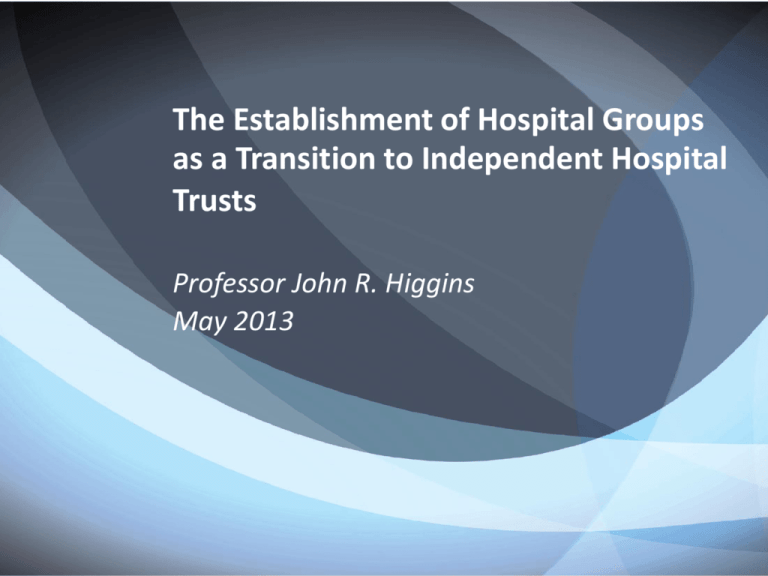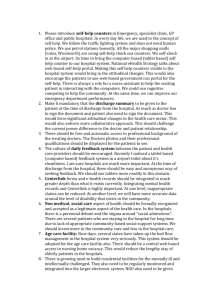Academic Partner
advertisement

The Establishment of Hospital Groups as a Transition to Independent Hospital Trusts Professor John R. Higgins May 2013 Context • Programme for Government • ‘Section 10’ letter - March 2012 • Project Team and Strategic Board - June 2012 Rationale • Large number and range of acute hospitals, operating in relative isolation • Duplication and fragmentation of resource • Difficulty in recruitment and retention of key clinical staff • Non-compliance with EU directives • Inequitable distribution of workload and resources Vision The formation of hospital groups which will transition to independent hospital trusts will change how hospitals relate to each other and integrate with the academic sector. Over time, it will deliver: – – – – – Higher quality services More consistent standards of care More consistent access to care Stronger leadership Greater integration between the healthcare agenda and the teaching, training, research and innovation agenda Benefits for Patients • Safe, high quality care • Maximise locally delivered care • Optimally skilled clinicians for the delivery of specialised complex care • Integrated care pathways • Patient choice Benefits for Staff • • • • • Greater certainty accessing and providing services Multidisciplinary teams working across multiple sites Create opportunities for staff Maintain rotas; comply with EWTD Academic linkage to the benefit of all grades and locations Hospital Groups • Safe equitable access to high quality care for the population; consistent with Small Hospitals Framework and Clinical Programmes • New name, CEO and Board • Strategic Plan for hospital configuration and integration within one year • Cooperation with other groups and wider health services • Staff appointment to, and deployment within group • Evaluation in advance of trust status • Cross border co-operation • Primary academic partner Recommended Composition of Hospitals Dublin North East • • • • • • • Beaumont Hospital Our Lady of Lourdes Hospital, Drogheda Connolly Hospital Cavan General Hospital Rotunda Hospital Louth County Hospital Monaghan Hospital Academic Partner: Royal College of Surgeons in Ireland (RCSI) Recommended Composition of Hospitals Dublin Midlands • St James's Hospital • The Adelaide & Meath Hospital, Dublin, including the National Children’s Hospital • Midlands Regional Hospital Tullamore • Naas General Hospital • Midlands Regional Hospital Portlaoise • the Coombe Women & Infant University Hospital. Academic Partner: Trinity College Dublin (TCD) Recommended Composition of Hospitals Dublin East • • • • • • • • • • Mater Misericordiae University Hospital St Vincent's University Hospital Midland Regional Hospital Mullingar St Luke's General Hospital Kilkenny Wexford General Hospital National Maternity Hospital Our Lady's Hospital Navan St Columcille's Hospital St Michael’s Hospital Dun Laoghaire Cappagh National Orthopaedic Hospital • Royal Victoria Eye and Ear Hospital Academic Partner: University College Dublin (UCD) Recommended Composition of Hospitals South / South West • • • • • • • • • Cork University Hospital/CUMH Waterford Regional Hospital Kerry General Hospital Mercy University Hospital South Tipperary General Hospital South Infirmary Victoria University Hospital Bantry General Hospital Mallow General Hospital Lourdes Orthopaedic Hospital, Kilcreene Academic Partner: University College Cork (UCC) Recommended Composition of Hospitals West / North West • University Hospital Galway and Merlin Park University Hospital • Sligo Regional Hospital • Letterkenny General Hospital • Mayo General Hospital • Portiuncula Hospital • Roscommon County Hospital Academic Partner: National University of Ireland, Galway (NUIG) Recommended Composition of Hospitals Midwest • • • • • • Mid-Western Regional Hospital, Limerick Ennis General Hospital Nenagh General Hospital St John's Hospital Limerick Mid-Western Regional Maternity Hospital Mid-Western Regional Orthopaedic Hospital Academic Partner: University of Limerick (UL) Governance of Transitional Hospital Groups • Non-statutory basis, subject to formal evaluation • Academic Healthcare Centre Model can be used for overarching governance • Primacy of service provision • Interim Group Board 6-9 members, skills based, governance training • Report to HSE or successor, annual business plan/MoU • Audit by HSE but group flexibility re service delivery • Minister to appoint Chair, Chair to nominate group to Minister for appointment Governance of Transitional Hospital Groups (cont’d…) • • • • Role of Chair and CEO not combined Quality improvement framework HIQA Tallaght Hospital Investigation Report – Full implementation of governance recommendations – Subcommittees to oversee specific functions – Board composition – Evaluation Voluntary delegation of powers and common membership to achieve interim group board Leadership Posts • • • • • • • • • Chief Executive Officer Chief Clinical Director Chief Academic Officer Chief Director of Nursing Chief Finance Officer Chief Operations Officer International “Buddy” Utilise management potential of wider public service Compliance with legislation and codes of practice Management Functions • • • • Led by CEO; Legally accountable to HSE or successor Individual hospital management teams dependent on hospital size and range of services Prepare for trust status; high quality safe patient care • Common corporate business platforms • Compliance with shared service policy in the public service Individual hospital managers accountable to group CEO either directly (HSE hospitals) or via hospital board (voluntary / joint board hospitals) Recruitment of Trust CEO • Well functioning Hospital Groups will transition to Hospital Trusts . CEO recruitment will require: – Open international competition, Public Appointments Service, (PAS) – Search and selection committee – 5-yr appointment, subject to performance review by board Role of Chief Executive Officer • Lead the group: manage resources, assets and staffing levels (including recruitment) • Adhere to national and EU public procurement / competitive tendering requirements and initiatives • Merge site specific services to reduce duplication Information sharing ICT communication within group, with other groups and wider health / social services • Risk Management • Audit • Capital spending and service development supported by business plan to HSE/DoH • Quality and safety framework • Compliance with Professional Codes of Conduct, Ethics in Public Office etc. Academic Involvement • Engagement on tripartite mission; – Service, Research, Education – Primacy of service imperative but “research, education and training are crucial for innovation that can sustainably improve service provision. For this reason this report correctly emphasises the importance of academic linkages for effective hospital groups” • Primary academic partner for each group • Chief Academic Officer key member of management team • Academic Health Centre model of acute hospital care provision Implementation • Two groups established – Galway and Midwest. • Implementation Plan (3/12) 1. Meeting with each new hospital group 2. Hospital Groups Implementation Team (HGIT) and Hospital Groups Steering Group (HGSG) establishment 3. A Chairperson will be appointed for each Hospital Group. 4. Commence appointment of Group CEOs 5. Front-line information and consultation at all acute hospitals Thank you for your attention ~ Comments and Questions






